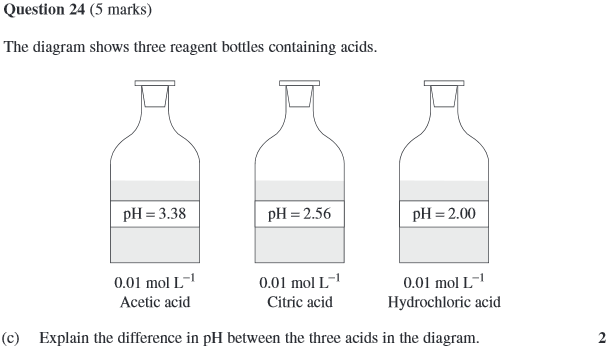re: HSC Chemistry Marathon Archive
(a) Explain why refluxing is a suitable means of preparing an ester. (3)
(b) Name the catalyst used. (1)
(c) Give a method to how this experiment should be performed. (5)
(d) Sometimes, it helps to wash the ester with Na2CO3 or NaHCO3. Why is this the case? (2)
Here's my practical report on this if anyone needs information:
5.1 Preparation of an Ester
Aim:
To prepare an ester using reflux.
Equipment:
• Reaction Flask
• Boiling Chips
• Condenser With Water Hoses
• Heating Mantle
• Separating Funnel With a Stopper
• 2 x Bosshead
• Retort Stand
• Distilled Water
• 1 ml Solution of Concentrated Sulphuric Acid
• 10 ml Solution of 1-Pentanol
• 12 ml Solution of Glacial Acetic Acid
• 15 ml Solution of 0.1 mol L-1 Sodium Carbonate
Note: Glacial acetic acid is the most concentrated form of acetic acid.
Method:
1) Place 10 ml of 1-Pentanol, 12 ml of glacial acetic acid and 1 ml of concentrated sulphuric acid into the reaction flask.
2) Add a few boiling chips, which are not made of marble, and assemble the refluxing apparatus. Clamp the flask and condenser securely to a retort stand by using the bossheads.
3) Connect the tubing to the tap and the condenser, and turn the tap on so that a uniform flow of water is achieved.
4) Heat the mixture in a heating mantle for approximately 30 minutes and allow to cool for 5 minutes. Turn off the water, as the refluxing apparatus is no longer required.
5) Carefully remove the flask and pour the contents into a separating funnel containing 15 ml of water. Put the stopper on the funnel and shake it. Allow the layers to separate, and drain off and discard the lower aqueous layer.
6) Add approximately 15 ml of 0.1 mol L-1 sodium carbonate solution. Put the stopper on the funnel and shake it. Allow the layers to separate, and drain off and discard the lower aqueous layer. The remaining solution in the separating funnel is the ester.
7) Carefully smell the ester and describe the smell.
 Safety:
Safety:
Concentrated sulphuric acid and glacial acetic acid are corrosive, and so handle with care by avoiding contact with skin. If contact occurs, wash the affected area with plenty of water. 1-Pentanol and 1-Pentyl Ethanoate are flammable so avoid contact with naked flames.
Results:
The ester formed smelt similar to that of the fruit, banana.
Discussion / Conclusion:
In this experiment, the independent variable was the type of alkanol and alkanoic acid used, whilst the dependent variable was the odour of the ester formed. The ester was successfully created and smelt of banana. The boiling chips were added to the reaction flask so as to facilitate a slow and gentle heating. By placing distilled water in the separating funnel prior to adding the contents of the reaction flask, the purity of the ester was increased since all the reactants and products except for the ester are water soluble, hence they are immiscible with the ester. Furthermore, the ester is also less dense and floated on top, allowing the aqueous reactants to be drained off. Finally, the base was added to neutralise any acid remaining in the mixture. The high temperature allowed for a faster rate of reaction, and thus equilibrium could be reached much faster. Moreover, esterification is an endothermic reaction, so by increasing the heat, equilibrium will encourage the forward reaction, hence increasing the yield of the ester. The addition of the sulphuric acid catalyst increased the rate of reaction, and thus equilibrium could be reached much faster. Moreover, as concentrated sulphuric acid is a powerful dehydrating agent, the concentration of the product water is reduced, and hence equilibrium will encourage the forward reaction, thus increasing the yield of the ester. Refluxing ensures that the condenser captures the volatile reactants and products (These are flammable and involve the alkanol, alkanoic acid and ester), returning them into the reaction mixture, and also prevents the build-up of pressure in a closed reaction vessel.
Apologies for it being bad expression-wise, I haven't gone back to fixing up these notes in ages ~
EDIT:
With my conclusion/discussion I don't tend to involve validity, etc. I just add in things that I may have to refer to in the exam but can relate it to validity, etc.






